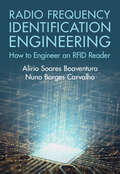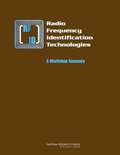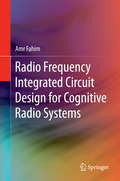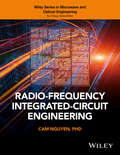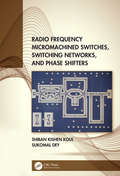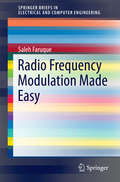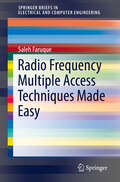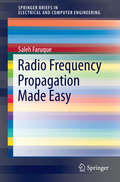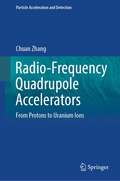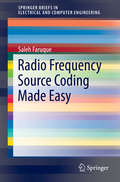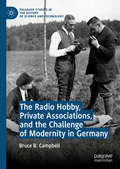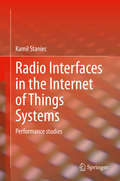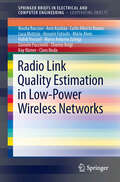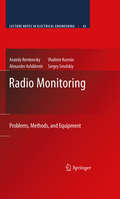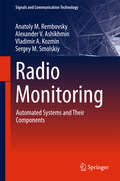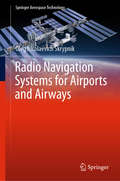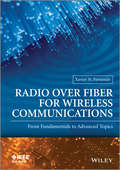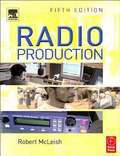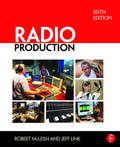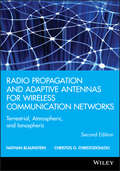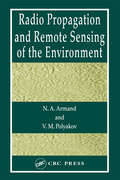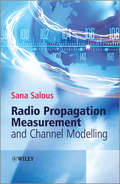- Table View
- List View
Radio Frequency Identification Engineering: How to Engineer an RFID Reader
by Alírio Soares Boaventura Nuno Borges CarvalhoRadio Frequency Identification Engineering Radio frequency identification (RFID) has become an undeniable aspect of modern living, being used from logistics, access control, and electronic payment systems to artificial intelligence, and as a key building block of the internet of things. Presenting a unique coverage of RFID reader design and engineering, this is a valuable resource for engineers and researchers, aiding in their mission of fulfilling current and future demands in the RFID space. Providing a cohesive compilation of technical resources for full-stack engineering of RFID readers, the book includes step-by-step techniques, algorithms, and source code that can be incorporated in custom designs. Readers are invited to explore the design of RFID interrogators based on software-defined radio for flexible, upgradeable solutions as well as low-complexity techniques for engineering low-cost RFID readers. Additionally, the authors provide insight into related topics such as waveform design optimization for improved reading range and novel quadrature backscatter modulation techniques.
Radio Frequency Identification Technologies: A Workshop Summary
by Committee on Radio Frequency Identification TechnologiesRadio Frequency Identification (RFID) technology is gaining rapid acceptance as a means to track a wide array of manufactured objects. Currently, RFID technologies have shown promise in transportation (e.g., smart fare cards) and commerce (e.g., inventory control) for a variety of uses and are likely to find many new applications in both military and civilian areas if and when current technical issues are resolved. There are a number of policy concerns (e.g., privacy), however, that will become more crucial as the technology spreads. This report presents a summary of a workshop, held by the NRC at the request of the Defense Advanced Research Projects Agency, to explore many of the key technical and policy issues. Several important themes that are likely to govern expansion of RFID technology emerged from the workshop and are discussed.
Radio Frequency Integrated Circuit Design for Cognitive Radio Systems
by Amr FahimThis book fills an information gap on cognitive radios, since the discussion focuses on the implementation issues that are unique to cognitive radios and how to solve them at both the architecture and circuit levels. This is the first book to describe in detail cognitive radio systems, as well as the circuit implementation and architectures required to implement such systems. Throughout the book, requirements and constraints imposed by cognitive radio systems are emphasized when discussing the circuit implementation details. This is a valuable reference for anybody with background in analog and radio frequency (RF) integrated circuit design, needing to learn more about integrated circuits requirements and implementation for cognitive radio systems.
Radio-Frequency Integrated-Circuit Engineering
by Cam NguyenRadio-Frequency Integrated-Circuit Engineering addresses the theory, analysis and design of passive and active RFIC's using Si-based CMOS and Bi-CMOS technologies, and other non-silicon based technologies. The materials covered are self-contained and presented in such detail that allows readers with only undergraduate electrical engineering knowledge in EM, RF, and circuits to understand and design RFICs. Organized into sixteen chapters, blending analog and microwave engineering, Radio-Frequency Integrated-Circuit Engineering emphasizes the microwave engineering approach for RFICs. * Provides essential knowledge in EM and microwave engineering, passive and active RFICs, RFIC analysis and design techniques, and RF systems vital for RFIC students and engineers * Blends analog and microwave engineering approaches for RFIC design at high frequencies * Includes problems at the end of each chapter
Radio Frequency Integrated Circuits and Systems
by Hooman DarabiFocusing on the core topics of RF IC and system design, this textbook provides the in-depth coverage and detailed mathematical analyses needed to gain a thorough understanding of the subject. Throughout, theory is linked to practice with real-world application examples; practical design guidance is also offered, covering the pros and cons of various topologies, and preparing students for future work in industry. Written for graduate courses on RFICs, this uniquely intuitive and practical book will also be of value to practising RF IC and system designers. Key topics covered include RF components, signals and systems; two-ports; noise; distortion; low-noise amplifiers; mixers; oscillators; power amplifiers; and transceiver architectures. Lecture slides and a solutions manual for instructors are provided online to complete the course package.
Radio Frequency Micromachined Switches, Switching Networks, and Phase Shifters
by Shiban Kishen Koul Sukomal DeyRadio Frequency Micromachined Switches, Switching Networks, and Phase Shifters discusses radio frequency microelectromechanical systems (RF MEMS)-based control components and will be useful for researchers and R&D engineers. It offers an in-depth study, performance analysis, and extensive characterization on micromachined switches and phase shifters. The reader will learn about basic design methodology and techniques to carry out extensive measurements on MEMS switches and phase shifters which include electrical, mechanical, power handling, linearity, temperature stability, reliability, and radio frequency performance. Practical examples included in the book will help readers to build high performance systems/subsystems using micromachined circuits. <P><P> Key Features <li> Provides simple design methodology of MEMS switches and switching networks including SPST to SP16T switches <li> Gives an in-depth performance study of micromachined phase shifters. Detailed study on reliability and power handling capability of RF MEMS switches and phase shifters presented <li> Proposes reconfigurable micromachined phase shifters <li> Verifies a variety of MEMS switches and phase shifters experimentally
Radio Frequency Modulation Made Easy
by Saleh FaruqueThis book introduces Radio Frequency Modulation to a broad audience. The author blends theory and practice to bring readers up-to-date in key concepts, underlying principles and practical applications of wireless communications. The presentation is designed to be easily accessible, minimizing mathematics and maximizing visuals.
Radio Frequency Multiple Access Techniques Made Easy (SpringerBriefs in Electrical and Computer Engineering)
by Saleh FaruqueThis book provides a comprehensive overview of multiple access techniques used in the cellular industry. The usage of multiple access techniques in telecommunications enables many users to share the same spectrum in the frequency domain, time domain, code domain or phase domain. Licenses are given, by the FCC, to operate wireless communication systems over given bands of frequencies, with the smaller bands, (channels), reused to provide services to other users. Thus, bandwidth efficiency is vital, as the speed and size of digital data networks continue to expand. This brief also uses numerous illustrations to bring students up-to-date in the practical applications of multiple access techniques, which can then be put to work in the industry. Primarily, electrical engineering students who study telecommunications, as well as engineers and designers working in wireless communications, would find this book useful.
Radio Frequency Propagation Made Easy
by Saleh FaruqueThis book introduces Radio Frequency Propagation to a broad audience. The author blends theory and practice to bring readers up-to-date in key concepts, underlying principles and practical applications of wireless communications. The presentation is designed to be easily accessible, minimizing mathematics and maximizing visuals.
Radio-Frequency Quadrupole Accelerators: From Protons to Uranium Ions (Particle Acceleration and Detection)
by Chuan ZhangThis book guides readers into the realm of particle accelerators, which have served as indispensable tools for fundamental research, energy development, medical therapy, industrial applications, national security, etc., since 1924. Towards a new generation of high power proton and ion accelerators, challenges often come from space charge effects, which are most pronounced in low-velocity beams. This book focuses on Radio-Frequency Quadrupole (RFQ) accelerators, one of the most popular front-end structures for accelerator facilities, and their beam physics. Uncovering the limitations of the classic design methods, novel approaches to achieve efficient RFQ accelerators with high beam quality will be presented. In addition, new ideas for possible future developments, such as how to realize long RFQs with high performance and how RFQs can be applied for much higher beam-velocities to shorten large-scale accelerators, will be introduced. To provide a general overview of the research and development of RFQs accelerating particle species from protons to uranium ions, this book uses over 10 real examples developed or proposed in the twenty-first century for various facilities of different dimensions (from large scale e.g. a collider to small scale e.g. university experimental setups). With its rich content and comprehensive scope, this book is an invaluable reference for researchers and graduate students interested in RFQ accelerators and the intricacies of space charge physics in low-velocity beams.
Radio Frequency Source Coding Made Easy
by Saleh FaruqueThis book introduces Radio Frequency Source Coding to a broad audience. The author blends theory and practice to bring readers up-to-date in key concepts, underlying principles and practical applications of wireless communications. The presentation is designed to be easily accessible, minimizing mathematics and maximizing visuals.
The Radio Hobby, Private Associations, and the Challenge of Modernity in Germany (Palgrave Studies in the History of Science and Technology)
by Bruce B. CampbellIn the early twentieth century, the magic of radio was new, revolutionary, and poorly understood. A powerful symbol of modernity, radio was a site where individuals wrestled and came to terms with an often frightening wave of new mass technologies. Radio was the object of scientific investigation, but more importantly, it was the domain of tinkerers, “hackers,” citizen scientists, and hobbyists. This book shows how this wild and mysterious technology was appropriated by ordinary individuals in Germany in the first half of the twentieth century as a leisure activity. Clubs and hobby organizations became the locus of this process, providing many of the social structures within which individuals could come to grips with radio, apart from any media institution or government framework. In so doing, this book uncovers the vital but often overlooked social context in which technological revolutions unfold.
Radio in Revolution: Wireless Technology and State Power in Mexico, 1897–1938 (The Mexican Experience)
by J. Justin CastroLong before the Arab Spring and its use of social media demonstrated the potent intersection between technology and revolution, the Mexican Revolution employed wireless technology in the form of radiotelegraphy and radio broadcasting to alter the course of the revolution and influence how political leaders reconstituted the government.Radio in Revolution, an innovative study of early radio technologies and the Mexican Revolution, examines the foundational relationship between electronic wireless technologies, single-party rule, and authoritarian practices in Mexican media. J. Justin Castro bridges the Porfiriato and the Mexican Revolution, discussing the technological continuities and change that set the stage for Lázaro Cárdenas’s famous radio decree calling for the expropriation of foreign oil companies. Not only did the nascent development of radio technology represent a major component in government plans for nation and state building, its interplay with state power in Mexico also transformed it into a crucial component of public communication services, national cohesion, military operations, and intelligence gathering. Castro argues that the revolution had far-reaching ramifications for the development of radio and politics in Mexico and reveals how continued security concerns prompted the revolutionary victors to view radio as a threat even while they embraced it as an essential component of maintaining control.
Radio Interfaces in the Internet of Things Systems: Performance studies
by Kamil StaniecThe book gives a broad overview of the Internet of Things (IoT) concept from various angles. The book provides rationale for: the concept development; its regulatory and technical background associated aspects such as the ambient and edge intelligence; fog computing; capillary networks and machine-type communications; etc. Each of these items is then extended in further respective chapters that deal with technicalities behind them. Chapters: 2-5, 8, 10-11 are addressed to those who seek expository IoT-related information on aspects such as the pathloss calculation, narrowband radio interfaces, radiation masks, spectrum matters, medium access control, and a transmission frame construction. That section ends with an exhaustive description of the six most popular IoT systems: LoRa, Weightless, SigFox, NB-IoT, LTE-M(TC) and EC-GSM IoT. Specialists and network designers may find chapters 6 and 7 interesting where a novel methodology is proposed for testing narrowband IoT systems performance for immunity to electromagnetic interference (EMI) and multipath propagation, both emulated in artificial conditions of the anechoic and the reverberation chamber.
Radio Link Quality Estimation in Low-Power Wireless Networks
by Marco Antonio Zuniga Carlo Alberto Boano Claro Noda Luca Mottola Habib Youssef Hossein Fotouhi Daniele Puccinelli Anis Koubâa Kay Römer Mário Alves Nouha Baccour Thiemo VoigtThis book provides a comprehensive survey on related work for radio link quality estimation, which covers the characteristics of low-power links, the fundamental concepts of link quality estimation in wireless sensor networks, a taxonomy of existing link quality estimators and their performance analysis. It then shows how link quality estimation can be used for designing protocols and mechanisms such as routing and hand-off. The final part is dedicated to radio interference estimation, generation and mitigation.
Radio Monitoring
by Alexander Ashikhmin Vladimir Kozmin Sergey M. Smolskiy Anatoly RembovskyRadio Monitoring: Problems, Methods, and Equipment offers a unified approach to fundamental aspects of Automated Radio Monitoring (ARM). The authors discuss the development, modeling, design, and manufacture of ARM systems. Data from established and recent research are presented and recommendations are made on methods and approaches for solving common problems in ARM. The authors also provide classification and detailed descriptions of modern high-efficient hardware-software ARM equipment, including the equipment for detection, radio direction-finding, parameters measurement and their analysis, and the identification and localization of the electromagnetic field sources. Examples of ARM equipment structure, applications, and software are provided to manage a variety of complicated interference environment in the industrial centers, inside of the buildings, and in the open terrain. This book provides a reference for professionals and researchers interested in deploying ARM technology as a tool for solving problems from radio frequency spectrum usage control.
Radio Monitoring: Problems, Methods And Equipment (Lecture Notes In Electrical Engineering #43)
by Anatoly M. Rembovsky Alexander V. Ashikhmin Vladimir A. Kozmin Sergey M. SmolskiyThis book discusses the architecture of modern automated systems for spectrum monitoring including automation components: technical means for spectrum monitoring, special software and engineering infrastructure. The problems of automated system development for search and localization of unauthorized radio emission sources in open localities, mathematical methods and algorithms for modulation of parameter measurements for wireless communication as well as issues of identification and localization of radio emission sources are considered. Constructive solutions and modern technical means for radio monitoring and their application are given. Numerous examples are described for the implementation of automated systems, digital radio receivers and radio direction-finders, analyzers of parameters for GSM, CDMA, LTE, DVB-T/T2, Wi-Fi, DMR, P25, TETRA and DECT signals. Practical implementations of the described methods are presented in applied software packages and in radio monitoring equipment.
Radio Navigation Systems for Airports and Airways (Springer Aerospace Technology)
by Oleg Nicolaevich SkrypnikThis book highlights the design principles of ground based radio-navigation systems used in solving navigation tasks in the airfield and on air routes. Mathematical correlations are illustrated that describe its operation, peculiarities of disposition, main technical characteristics, generalized structural diagrams as well as the inter-operation with onboard equipment. Examples of building, construction, functional diagrams, and characteristics of Russian made radio-navigation systems are discussed. This book is written for students of electronics and aviation disciplines. It can also be useful for aviation specialists as well as for those interested in air radio-navigation.
Radio over Fiber for Wireless Communications: From Fundamentals to Advanced Topics (Wiley - IEEE)
by Xavier N. FernandoA comprehensive evaluation of Fi-Wi, enabling readers to design links using channel estimation and equalization algorithms This book provides a detailed study of radio over fiber (ROF) based wireless communication systems, otherwise called fiber wireless (Fi-Wi) systems. This is an emerging hot topic where the abundant bandwidth of optical fiber is directly combined with the flexibility and mobility of wireless networks to provide broadband connectivity. Its application is increasing because of the growing demand for broadband wireless services. In such a system the transmission of the radio signals over a fiber is an important task. This book provides substantial material on the radio over fiber part of the complete fiber-wireless system, including new research results on the compensation methods. The early chapters provide fundamental knowledge required for a non-expert engineering professional as well as senior/graduate level students to learn this topic from scratch. The latter part of the book covers advanced topics useful for researchers and senior students. Therefore, this book provides a comprehensive understanding of the system for readers who will gain enough knowledge to design Fi-Wi links of their own by learning how to develop Fi-Wi channel estimation and equalization algorithms. This concept is completely novel in current literature and has been patented by the author. Readers are expected to have a basic understanding of fiber optics and wireless communications to easily follow the book and to appreciate the concepts. Basics of the Fi-Wi system and signal processing approaches are clearly explained. It covers a multidisciplinary topic and acts as a bridge between optical and wireless communication domains. In the increasingly demanding telecommunications profession, engineers are expected to have knowledge in both optical and wireless communications and expected design combined/hybrid systems. Hence, the book is written in such a way that both optical and wireless professionals will be able to easily understand and perceive the concepts. follows a logical process from basic principles through to advanced topics, providing a wide range of interest for researchers, practicing engineers, students, and those required to build such networks explains detailed system design concepts and the limitations and advantages in each configuration, appealing to design engineers, and largely avoiding system specifics demonstrates the author’s exclusive patent, showing how to develop baseband signal processing algorithms for Fi-Wi systems, which is a key requirement for the successful deployment of Fi-Wi systems contains tables, numerical examples and case studies, facilitating a good quantitative understanding of the topic
Radio Production
by Robert McleishThis classic book is a must-have for anyone involved in radio production, covering everything from operational techniques and producing different programme formats, to conducting interviews and writing for radio.The fifth edition features new and updated information on:* digital production, such as the computer editing process, digital recording and DAB* the internet and internet-only radio stations* automatic playout systems* ethics* storytelling, showing simple ways of creating different acoustics for drama* station management* scheduling* remote reportingThis edition is further enhanced by a supporting CD-Rom, packed with examples, exercises and resources.
Radio Production: A Manual For Broadcasters (The\library Of Communication Techniques)
by Robert McLeish Jeff LinkRadio Production is for professionals and students interested in understanding the radio industry in today’s ever-changing world. This book features up-to-date coverage of the purpose and use of radio with detailed coverage of current production techniques in the studio and on location. In addition there is exploration of technological advances, including handheld digital recording devices, the use of digital, analogue and virtual mixing desks and current methods of music storage and playback. Within a global context, the sixth edition also explores American radio by providing an overview of the rules, regulations, and purpose of the Federal Communications Commission. The sixth edition includes: Updated material on new digital recording methods, and the development of outside broadcast techniques, including Smartphone use. The use of social media as news sources, and an expansion of the station’s presence. Global government regulation and journalistic codes of practice. Comprehensive advice on interviewing, phone-ins, news, radio drama, music, and scheduling. This edition is further enhanced by a companion website, featuring examples, exercises, and resources: www.focalpress.com/cw/mcleish.
Radio Propagation and Adaptive Antennas for Wireless Communication Networks
by Christos G. Christodoulou Nathan BlaunsteinExplores novel wireless networks beyond 3G, and advanced 4G technologies, such as MIMO, via propagation phenomena and the fundamentals of adapted antenna usage.Explains how adaptive antennas can improve GoS and QoS for any wireless channel, with specific examples and applications in land, aircraft and satellite communications.Introduces new stochastic approach based on several multi-parametric models describing various terrestrial scenarios, which have been experimentally verified in different environmental conditionsNew chapters on fundamentals of wireless networks, cellular and non-cellular, multiple access networks, new applications of adaptive antennas for positioning, and localization of subscribersIncludes the addition of problem sets at the end of chapters describing fundamental aspects of wireless communication and antennas.
Radio Propagation and Remote Sensing of the Environment
by N.A. Armand V.M. PolyakovThis book describes the processes of radio propagation and analyzes the equations that enable estimation of media. It explores propagation processes and related phenomena including absorption, refraction, reflection, and scattering. It also analyzes how knowledge of radiowave properties allows accurate estimations of media via inverse problems.
Radio Propagation Measurement and Channel Modelling
by Sana SalousWhile there are numerous books describing modern wireless communication systems that contain overviews of radio propagation and radio channel modelling, there are none that contain detailed information on the design, implementation and calibration of radio channel measurement equipment, the planning of experiments and the in depth analysis of measured data.The book would begin with an explanation of the fundamentals of radio wave propagation and progress through a series of topics, including the measurement of radio channel characteristics, radio channel sounders, measurement strategies, data analysis techniques and radio channel modelling. Application of results for the prediction of achievable digital link performance would be discussed with examples pertinent to single carrier, multi-carrier and spread spectrum radio links. This work would address specifics of communications in various different frequency bands for both long range and short range fixed and mobile radio links.
Radio Protocols for LTE and LTE-Advanced
by SeungJune Yi SungDuck Chun YoungDae Lee SungJun Park SungHoon JungProvides a unique focus on radio protocols for LTE and LTE-Advanced (LTE-A) Giving readers a valuable understanding of LTE radio protocols, this book covers LTE (Long-Term Evolution) Layer 2/3 radio protocols as well as new features including LTE-Advanced. It is divided into two sections to differentiate between the two technologies’ characteristics. The authors systematically explain the design principles and functions of LTE radio protocols during the development of mobile handsets. The book also provides essential knowledge on the interaction between mobile networks and mobile handsets. Among the first publications based on the 3GPP R10 specifications, which introduces LTE-A Beginning with an overview of LTE, topics covered include: Idle Mode Procedure; Packet Data Convergence Protocol and Public Warning Systems Presents the LTE radio interface protocol layers in a readable manner, to enhance the material in the standards publications From an expert author team who have been directly working on the 3GPP standards It is targeted at professionals working or intending to work in the area and can also serve as supplementary reading material for students who need to know how theory on the most extensively used mobile radio interface today is put into practice
